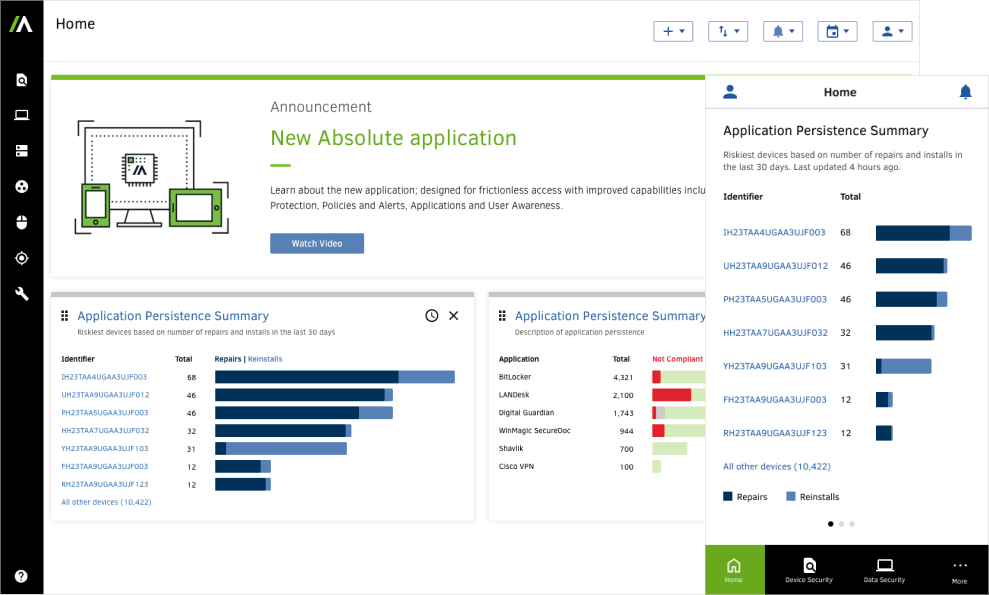Work / Endpoint Security Platform
Absolute SoftwareEndpoint Security Platform Redesign

Platform issues
A few years before the design and product management teams joined the company, Absolute had begun rewriting its security management platform. A more modern user interface framework was being used, but the new product had been inserted as another set of choices in the main navigation of the older, complete product. Unfortunately, there was no UX strategy for how to deal with this.

Older (DDS 5) and newer (DDS 6) application
The applications didn't utilize a task-oriented flow.
The engineering group had defined the interaction design, and the applications did not utilize a task-oriented flow; rather, they were based on database object types, development team organizational structure, and chronology of development.The two products had different interaction design patterns.
The old product was, quite unusually, based on an action-selection model, the opposite of most modern user interfaces. For example, if the user had found an object on which they wanted to perform an action, they had to leave the object, find the operation of interest, and re-find the object before finally applying the action. An analogy: if you were looking at my CV PDF, and wanted to print it, you'd have to close the file, go to the "print" section of the app, find my CV again, and then print it.
Our objective
The design team's objective was to amalgamate these platform issues into a modern, coherent whole, setting a foundation for the future while addressing usability issues and simultaneously adding new features.
Design vision
Before I joined the design team, the design manager put together some initial aspirational concepts for the web and mobile applications based on preliminary task analysis, user feedback, and consolidation to selection-action patterns to show what was possible and help the company modernize the platform.

Initial aspirational concept

Initial aspirational concept
Design and testing
After I joined the design team, we began researching, designing and testing.
It took us longer than expected to complete research and testing because we didn't have a proper research process in place, so we had to rely on customer-facing teams to help us find and recruit participants.
Card sorting
A central part of my work was an online card sort to test how the application should be structured around capabilities rather than data types and (Absolute) organizational structure. I carefully represented all functionality in the card sort in an implementation-independent manner to not reflect the existing categories in the current products.

Application content hierachy
Card sorting results
The results showed that users wanted like-with-like capabilities in a task-oriented flow.

Part of the results analysis from Optimal Workshop card sorting tool

Part of the results analysis from Optimal Workshop card sorting tool
Prototype testing
Then we proceeded to detailed design and prototypes, which we tested with end users. Despite a few minor usability issues, which we fixed, the prototype performed well with a total average System Usability Scale (SUS) score of 80.Deliverables
We produced high-fidelity mockups and extensive interface guidelines.

New application mockup

New application mockup

New application mockup

New application mockup

New application mockup

New mobile application mockups

New nested list navigation pattern

New web application layout archetypes

New design system
Outcome
Despite the engineering teams having some challenges amalgamating like-with-like capabilities in the new product, we shipped the new product in 2017.
The modern security platform set a foundation for the future and enabling the company to deliver new features and expand its solutions.
Back to top